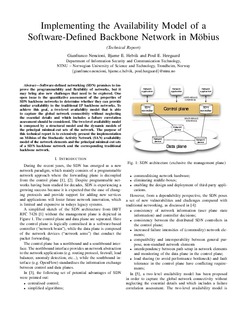Implementing the Availability Model of a Software-Defined Backbone Network in Möbius
| dc.contributor.author | Nencioni, Gianfranco | |
| dc.contributor.author | Helvik, Bjarne Emil | |
| dc.contributor.author | Heegaard, Poul Einar | |
| dc.date.accessioned | 2017-03-17T09:43:27Z | |
| dc.date.available | 2017-03-17T09:43:27Z | |
| dc.date.created | 2017-03-16T11:15:52Z | |
| dc.date.issued | 2017 | |
| dc.identifier.uri | http://hdl.handle.net/11250/2434484 | |
| dc.description.abstract | Software-defined networking (SDN) promises to im-prove the programmability and flexibility of networks, but it may bring also new challenges that need to be explored. One open issue is the quantitative assessment of the properties of SDN backbone networks to determine whether they can provide similar availability to the traditional IP backbone networks. To achieve this goal, a two-level availability model that is able to capture the global network connectivity without neglecting the essential details and which includes a failure correlation assessment should be considered. The two-level availability modelis composed by a structural model and the dynamic models of the principal minimal-cut sets of the network. The purpose ofthis technical report is to extensively present the implementation on M ̈obius of the Stochastic Activity Network (SAN) availability model of the network elements and the principal minimal-cut sets of a SDN backbone network and the corresponding traditional backbone network. | nb_NO |
| dc.language.iso | eng | nb_NO |
| dc.publisher | NTNU | nb_NO |
| dc.title | Implementing the Availability Model of a Software-Defined Backbone Network in Möbius | nb_NO |
| dc.type | Research report | nb_NO |
| dc.source.pagenumber | 74 s. | nb_NO |
| dc.identifier.cristin | 1458705 | |
| cristin.unitcode | 194,63,30,0 | |
| cristin.unitname | Institutt for telematikk | |
| cristin.ispublished | true | |
| cristin.fulltext | original |
